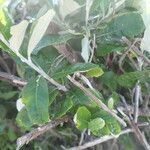Tree or shrub, 1.8-6.0(-10.0) m high. Leaves alternate, petiolate, oblanceolate to obovate, rarely oblong-elliptic, rounded, sometimes briefly acuminate at apex, ± narrowly cuneate and usually tapering to a long petiole, margins entire or dentate in apical part, upper surface shiny dull-green, glabrous, lower surface greyish tomentellous. Capitula large, discoid, unisexual, many together in dense, terminal panicles; involucre infundibuliform; bracts imbricate, extending onto upper part of capitulum stalk. Florets male and female on different plants. Corolla dull yellow or creamy white. Flowering time July-Oct. Pappus of many barbellate bristles. Cypselae subcylindric-subfusiform, ribbed, sparsely hairy.
Leaves with petioles mostly 5–16 mm. long; lamina mostly 5–12 x 1.3–5 cm., larger in coppice growth, oblanceolate to obovate, rarely oblong-elliptic, rounded sometimes briefly acuminate at apex, ± narrowly cuneate and usually tapering to a long petiole, entire and faintly revolute, or repand-dentate to serrate-or coarsely-dentate in the apical part, sometimes spinescent-denticulate; upper surface thinly araneose when young, or glabrous, shiny dull-green with subprominent reticulate venation; lower surface greyish tomentellous with prominent veins; lateral veins forked near the margin.
Phyllaries thinly coriaceous, acute, lanate on the margins otherwise glabrous; from c. 1 mm. long outside, the inner increasing to c. 4 mm. long in male capitula and to 6(9) mm. long in female capitula, becoming lanceolate or tapering-lorate; the outermost 5–11 series decreasing in size and extending onto upper part of the 1–10 mm. long capitulum stalk, the lower part of the capitulum stalk often with scattered small bracts or buds; bracts below the involucre lanate.
Female flowers: corollas 3–6 mm. long, terete narrowing to the apex, lobes erect up to c. 0.5 mm. long; achenes pale-brownish to purplish, 3–4 mm. long, subcylindric-subfusiform, narrowly c. 8-ribbed, sparsely puberulous; pappus several-seriate, setae 4–5(7) mm. long, ± terete, barbellate.
A shrub or tree to 10(12) m. tall, usually evergreen; branches brown to dark-purplish, lenticellate and narrowly sulcate, at first greyish tomentellous soon glabrescent, ± leafy throughout.
Male flowers: corollas dull-yellow, 3–5 mm. long, lobes c. 1 mm. long and ± recurved; pappus sparse, uniseriate, setae 3–4 mm. long with seta barbs ± equalling the seta axis in width.
Capitula numerous in dense terminal panicles 4–40 cm. long, or in short raceme-like panicles in leaf axils.
Involucres mostly narrowly obconic, somewhat cyathiform in male capitula.


